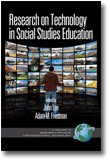
Research on Technology in Social Studies Education
Edited by:
John Lee, North Carolina State University
Adam M. Friedman, Wake Forest University
A volume in the series: Research, Innovation & Methods in Educational Technology. Editor(s): Chrystalla Mouza, University of Delaware. Nancy C. Lavigne, University of Delaware.
Published 2009
Despite technology’s presence in virtually every public school, its documented familiarity and use by youth outside of school, and the wealth of resources it provides for teaching social studies, there has been relatively little empirical research on its effectiveness for the teaching and learning of social studies. In an effort to begin to fill this gap in research literature, this book focuses on research on technology in social studies education. The objectives of this volume are threefold: to describe research frameworks, provide examples of empirical research, and chart a course for future research endeavors. Accordingly, the volume is divided into three overarching sections: research constructs and contexts, research reports, and research reviews.
The need for research is particularly acute within the field of social studies and technology. As the primary purpose of social studies is to prepare the young people of today to be the citizens of tomorrow, it is necessary to examine how technology tools impact, improve, and otherwise affect teaching and learning in social studies. Given these circumstances, we have prepared this collection of research conceptualizations, reports, and reviews to achieve three goals.
1. Put forward reports on how research is being conducted in the field
2. Present findings from well-designed research studies that provide evidence of how specific applications of technology are affecting teaching and learning in social studies.
3. Showcase reviews of research in social studies
It is with this framework that we edited this volume, Research on Technology and Social Studies Education, as an effort to address emerging concerns related to theorizing about the field and reporting research in social studies and technology. The book is divided into four sections. The first section of the book includes three descriptions of research constructs and contexts in social studies and technology. The second section is focused on research reports from studies of student learning in social studies with technology. The third section contains research reports on teachers’ pedagogical considerations for using technology in social studies. In the fourth and final section, we present work that broadly reviews and critiques research in focused areas of social studies and technology. This volume contains twelve chapters, each of which focuses on social studies content and pedagogy and how the field is affected and enhanced with technology. The volume includes research and theoretical works on various topics, including digital history, digital video, geography, technology use in the K-12 social studies classroom, and artificial intelligence.
CONTENTS
SECTION 1: RESEARCH CONSTRUCTS AND CONTEXTS. More to Follow: The Untapped Research Agenda in Social Studies and Technology, John K. Lee. Using the Affordances of Technology to Develop Teacher Expertise in Historical Inquiry, John W. Saye and Thomas Brush. Student-Created Digital Documentaries in the History Classroom: Outcomes, Assessment, and Research Design, Thomas Hammond and Bill Ferster. Conceptual Change and the Process of Becoming a Digital History Teacher, Philip E. Molebash, Rosemary Capps, and Kelly Glassett. SECTION 2: RESEARCH ON STUDENTS’ LEARNING IN SOCIAL STUDIES WITH TECHNOLOGY. Student and Teacher Perceptions of the WebQuest Model in Social Studies: A Preliminary Study, Phillip J. VanFossen. Multimedia-Based Historical Inquiry Strategy Instruction: Do Size and Form Really Matter? David Hicks and Peter E. Doolittle. SECTION 3: RESEARCH ON TEACHERS USING TECHNOLOGY IN SOCIAL STUDIES. If You Build It, Should I Run?: A Teacher’s Perspective on Implementing a Student-Centered, Digital Technology Project in His Ninth-Grade Geography Classroom, Sonja Heer Yow and Kathleen Owings Swan. Technology Integration: The Trojan Horse for School Reform, Cheryl Mason Bolick. The Effect of Teachers’ Conceptions of Student Abilities and Historical Thinking on Digital Primary Source Use, Adam M. Friedman. SECTION 4: RESEARCH REVIEWS. Utilizing the Power of Technology for Teaching with Geography, Tina L. Heafner. Artificial Intelligence in the Social Studies, Daniel W. Stuckart and Michael J. Berson. Digital History: Researching, Presenting, and Teaching History in a Digital Age, Fred Koehl and John K. Lee.
-
Paperback978-1-60752-278-2
Web price: $45.04 (Reg. 52.99)
-
Hardcover978-1-60752-279-9
Web price: $80.74 (Reg. 94.99)
- eBook978-1-60752-294-2

-
 Constructivist Instructional Design (C-ID)
Foundations, Models, and Examples
Constructivist Instructional Design (C-ID)
Foundations, Models, and Examples
-
 Evaluating Electronic Portfolios in Teacher Education
Evaluating Electronic Portfolios in Teacher Education
-
 Evaluating Technology in Teacher Education
Lessons From the Preparing Tomorrow’s Teachers for Technology (PT3) Program
Evaluating Technology in Teacher Education
Lessons From the Preparing Tomorrow’s Teachers for Technology (PT3) Program
-
 Frameworks for Integrated Project-Based Instruction in STEM Disciplines
Frameworks for Integrated Project-Based Instruction in STEM Disciplines
-
 Preparing Pre-Service Teachers to Teach Computer Science
Models, Practices, and Policies
Preparing Pre-Service Teachers to Teach Computer Science
Models, Practices, and Policies
-
 Professional Development for In-Service Teachers
Research and Practices in Computing Education
Professional Development for In-Service Teachers
Research and Practices in Computing Education
-
 Research on Technology in English Education
Research on Technology in English Education

